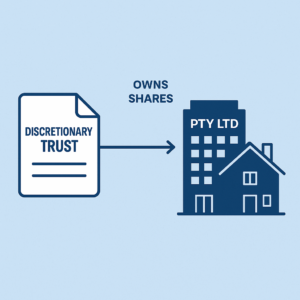Service Trust Business Structure in Australia
A service trust is a specialised business structure used to separate trading activities from service and administrative functions within a business.
In Australia, this structure is most commonly used by professional practices — such as medical, legal, and accounting firms — to improve asset protection, tax efficiency, and business continuity.
A service trust doesn’t perform the main income-generating activity (like treating patients or giving legal advice). Instead, it provides services — such as staffing, premises, equipment, and administration — to the main trading entity for a commercially reasonable fee.
How a Service Trust Works
A service trust operates alongside a trading entity (such as a company or partnership).
-
The trading entity earns income by providing professional services to clients.
-
The service trust owns and manages key assets, employs staff, leases premises, or provides management services to that trading entity.
-
The trust invoices the trading entity for those services, and income is then distributed to the trust’s beneficiaries in accordance with the trust deed.
This structure can deliver genuine commercial benefits — provided the fees charged are at arm’s length and documented through a formal service agreement.
Example: Service Trust in a Medical Practice
Let’s look at how this works in a real-world scenario:
Dr. Smith operates a medical clinic under Smith Medical Pty Ltd (the trading entity).
To protect assets and streamline operations, Dr. Smith sets up a service trust — Smith Services Trust — with a corporate trustee.
-
The service trust employs all reception and nursing staff, leases the premises, and owns the medical equipment.
-
It provides these services to Smith Medical Pty Ltd under a written service agreement.
-
Each month, the service trust invoices the trading company for the agreed service fee.
This fee covers the cost of wages, rent, consumables, administration, and an appropriate profit margin (markup).
After paying its expenses, the trust distributes the remaining profit to its beneficiaries (for example, Dr. Smith’s family trust).
This setup ensures:
✅ The clinic’s key assets are protected from trading risks.
✅ The business can operate smoothly even if ownership or structure changes.
✅ Profits are distributed efficiently, provided the arrangement is commercial and transparent.
ATO Guidance: What’s a “Reasonable” Markup?
The Australian Taxation Office (ATO) recognises that service trusts can have legitimate commercial purposes — but scrutinises them closely to ensure they’re not used for income splitting or tax avoidance.
According to ATO Taxation Ruling IT 276 (Service Entities) and subsequent guidance (TR 2006/2):
-
Service fees must be commercially realistic and in line with market value.
-
The markup applied by the service trust should reflect what an independent third party would charge for the same services.
-
Excessive markups or “profit shifting” to related parties can attract ATO scrutiny.
In practical terms, the ATO has historically accepted:
-
Markups of around 10% to 30% on direct costs as reasonable, depending on the nature of the services and industry.
-
For medical practices, a 20%–30% markup on administrative or service costs is generally considered commercially justifiable, provided it aligns with market conditions and is supported by documentation.
The key test is arm’s length pricing — meaning the trust should charge the same fee that an unrelated service provider would charge for the same services.
Trustify Tip: Always retain documentation (benchmarking, service agreements, fee calculations) to demonstrate that the arrangement is commercial and in line with ATO expectations.
Advantages
✅ Asset Protection
Separates valuable business assets (equipment, staff, IP) from trading risk.
✅ Tax Planning Flexibility
Profits from the service trust can be distributed to beneficiaries within the family or business group (subject to tax rules).
✅ Operational Efficiency
Centralises key business functions — HR, admin, facilities — improving management and scalability.
✅ Continuity and Succession Planning
Allows for smoother transition when ownership changes.
✅ Commercial Credibility
Clearly defines the relationship between trading and service entities.
Disadvantages
⚠️ Complex Setup and Management
Requires a trust deed, service agreement, and separate accounting systems.
⚠️ ATO Scrutiny
Arrangements that overstate service fees or shift profits can attract audits.
⚠️ Compliance Burden
Both entities must maintain separate financial records and tax filings.
⚠️ Higher Setup and Ongoing Costs
Professional fees for setup and annual compliance are higher than simpler structures.
When a Service Trust Is Suitable
A service trust structure may be appropriate if:
-
You operate a professional practice (medical, legal, accounting, consulting, etc.)
-
You want to protect valuable business assets from trading risk
-
You employ staff or manage shared business resources
-
You’re looking for tax-effective income distribution that complies with ATO rules
-
You’re planning for succession or growth in your practice
Key Obligations
To establish and operate a service trust in Australia:
-
Have a trust deed prepared by a qualified lawyer.
-
Appoint a trustee (individual or corporate).
-
Draft a formal service agreement with the trading entity.
-
Register for an ABN, TFN, and GST (if applicable).
-
Maintain separate books and tax returns for the trust.
-
Ensure service charges reflect commercial rates, supported by market evidence.
Trustify Tip: Conduct a regular review (at least every two years) to ensure your service fees remain consistent with ATO benchmarks and industry standards.
Summary
A service trust is an effective structure for separating ownership and operations within a professional practice.
It can enhance asset protection, tax efficiency, and business continuity, provided it’s established and maintained on a commercial, arm’s-length basis.
For medical and other professional practices, a well-structured service trust can provide long-term stability — but only when managed transparently and in accordance with ATO expectations.
Information current as of October 2025. Reviewed by the Trustify Business Advisory Team. General information only — not financial or legal advice.
Others
-
October 20, 2025 Buying Property Under Your Personal Name in Australia: Pros and Cons
-
October 18, 2025 SPV (Special Purpose Vehicle) Business Structure in Australia




